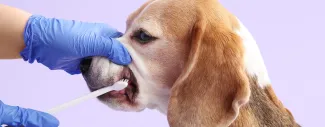Savvy breeders recognize that maintaining breeding animals in good dental health can positively impact a dam’s pregnancy and the health of her puppies.
“The current research in human medicine suggests that poor periodontal health in women contributes to lower birth weight, preterm labor and increased neonatal mortality,” says Christopher Smithson, DVM, DAVDC, who practices at The Pet Dentist at Tampa Bay in Wesley Chapel, Florida.
“While there is not a large data set to suggest this in dogs, we highly recommend keeping dams in good oral health and overall health before, during and after gestation,” Dr. Smithson says.
“More than 80 percent of dogs over 3 years of age have dental disease affecting the teeth, gums and structures that support their teeth.”
- Dr. Christopher Smithson
“Few dogs show signs of dental disease; thus, it progresses uninhibitedly making it the most undertreated canine health condition.”
Periodontal disease begins when plaque hardens into tartar below the gum line causing inflammation in the tissues that support the teeth and jawbone. One of the most common clinical conditions in dogs, periodontal disease may progress to a harmful systemic bacterial infection.
“After 72 hours, plaque that is not removed from the tooth surface begins to harden into tartar, or calculus, that is not easily removed by brushing or using other dental products,” Dr. Smithson explains.
Photos taken before and after periodontal treatment show the results when plaque is removed during a cleaning.
PHOTO COURTESY OF DR. CHRISTOPHER SMITHSON/THE PET DENTIST AT TAMPA BAY
The American Veterinary Dental College recommends professional dog teeth cleanings with radiographs under general anesthesia for small-breed dogs as early as 1 year of age and then every six to 12 months and for large breeds starting at 3 years of age followed by every 12 to 24 months based on the findings at a dog’s annual physical exam.
“These are general guidelines,” says Dr. Smithson, one of about 230 board-certified veterinary dental specialists across the U.S. “A patient should be treated on an individual basis. A dog’s dental health can be impacted by genetics, nutrition and environment. Even a dog’s breed, age and bloodline can contribute.”
In his practice, Dr. Smithson advocates for regular home dental cleanings and educates dog owners about the health risks when teeth are neglected.
Beyond bad breath, gingivitis, tooth loss and agonizing pain, periodontal disease carries the danger of dental plaque bacteria spreading to the bloodstream.
“Periodontal disease is a known risk factor for heart disease, liver disease and kidney disease in dogs,” Dr. Smithson says. “In people, periodontal disease can even contribute to diabetes. There is evidence that the same is true in dogs.”
Dental disease in dogs also includes inherited conditions. Dr. Smithson commonly treats these genetic dental disorders:
- Persistent, or retained, deciduous (“baby”) teeth in toy breeds
- Malocclusion, or misaligned teeth, causing mandibular prognathism (an underbite) or mandibular distoclusion (an overbite)
- Malocclusion in brachycephalic breeds, causing crowding of teeth or impacted mandibular first premolar teeth with painful fluid-filled odontogenic cysts
- Mesioverted maxillary canine teeth (“Lance” canines) in Shetland Sheepdogs, resulting in the upper canine teeth angling further forward than normal
“Affected dogs and breeding pairs that produce malocclusion should not be bred,” Dr. Smithson says. “In Shelties, there has been success selecting against Lance canines.”
Despite the complex cases he sometimes treats, the veterinary specialty dentist finds his work gratifying.
“It is so rewarding to see patients with dental diseases and problems that we can almost always fix,” Dr. Smithson says. “I love getting feedback from owners about how much better their dogs feel after their procedure. That never gets old.”
Dog Dental Care Basics
At-home dental care is essentially a 72-hour race to beat plaque from turning into tartar.
“Many dog owners wonder ‘what is the best way to clean dogs’ teeth at home?’ Dr. Smithson says, “Brushing the teeth with a veterinary approved toothpaste and a soft-bristled toothbrush is the best way to prevent plaque and tartar formation on the teeth and from eventual periodontal disease.”
“Ideally, tooth brushing should be performed daily, though every other day can also be effective,” he says. “Anything less than every other day is not effective.”
Training dogs to accept tooth brushing should start early.
“Dogs should receive dental home care as early as possible after the permanent teeth erupt, usually between 4 and 6 months of age.”
– Dr. Christopher Smithson
“Beginning earlier when puppies have their deciduous ‘puppy’ teeth can help train them to allow brushing.
“Dental care performed at home combined with regular periodontal treatments can help slow the progression of periodontal disease and tooth loss over time.”
Benefit-Based Dental Treats and Diets for Dogs
Proactive dog dental care for dogs may include dry food, treats and chews developed to help battle dental disease. These dental products combined with regular dental checkups and periodontal treatment may help promote dental health.
“More and more people are choosing treats for their dogs that offer functional benefits, such as preventive dental care,” says Purina Senior Veterinarian RuthAnn Lobos, DVM, CCRT, CVAT. “Dental is the top benefit owners see in value-added treats.
“Purina has developed a dental dry dog food and chew and oral treats that have the Veterinary Oral Health Council (VOHC) Seal of Approval,” Dr. Lobos says. “Their texture promotes teeth abrasion and significantly reduces tartar buildup.”
“I recommend selecting chew toys that can bend and are soft enough that you can imprint your thumbnail,” Dr. Smithson says. “Hard plastic toys and chews are typically too hard for their teeth and put pets at high risk for fractures.”
Dog owners should look for dental products that have the VOHC Seal of Approval indicating they meet the standards of effectiveness in dental plaque control approved in partnership with the American Veterinary Dental College.
Purina offers a range of food and treat products that have the VOHC Seal of Approval endorsing their effectiveness at controlling dental plaque.
